Working with page styles
- Applying styles
- Modifying styles
- Creating new (custom) styles
- Copying and moving styles
- Deleting styles
- Working with paragraph styles
- Outline numbering
- Defining a hierarchy of headings
- Working with list (numbering) styles
- Working with conditional paragraph styles
- Working with frame styles
- Working with page styles
In Writer, page styles define the basic layout of pages, including page size, margins, headers and footers, borders and backgrounds, number of columns, and so on.
Writer comes with several page styles, which you can modify as you wish, and you can define your own. You can have one or many page styles in a single document.
| All pages in a Writer document are based on styles. If you do not apply a specific page style, Writer uses the Default page style. Refer to Applying styles to change the page style. |
To change the layout of individual pages, either define a new page style or use one of the techniques (sections, frames, or tables) described in Chapter 4 (Formatting Pages).
This section describes one use of page styles. Other uses are discussed in Chapter 6 (Introduction to Styles) and Chapter 4 (Formatting Pages).
| Any modifications of page styles, including the Default page style, apply only to the document you are working on. If you want the changes to be the default for all documents, you need to put the changes into a template and make that template the default template. See Chapter 10 (Working with Templates) for details. |
Setting up a book chapter sequence of pages
Book chapters typically start on a right-hand page, with the first page of the chapter having a different layout from the rest of the pages. The other pages in the chapter are “mirrored" for double-sided printing. For example, page numbers in the header or footer may be positioned on the outside edge of pages and a wider margin (allowing for binding) may be placed on the inside edge.
Table 2 shows the properties of two page styles (Right Page and Default) set up for a typical book chapter's sequence of pages.
Table 2. Properties of customized page styles to be used in a book chapter
| Page Style | Desired effect | Property: setting | |
| Right Page | First page always on the right (an odd numbered page) | Page > Page Layout: Right | |
| No header or footer | Header > Header on: Not selected | ||
| Top margin of page larger than on other pages | Page > Margins > Top: 6.00cm | ||
| Default | Mirrored margins | Page > Page Layout: Mirrored | |
| Header with page number on the top outside of the page, and chapter title in the top middle center of the page | Header > Header on: Selected Header > Header > Same content left/right: Not selected |
The figure below illustrates the transitions from Right Page to Default, with the change of header between left and right pages shown by the # symbol.
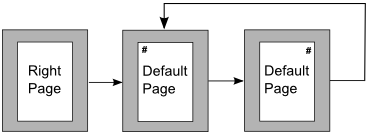
Right Page and then Default page style with different header for alternate pages
To apply this page scenario:
- Set up the page styles.
- On the Styles and Formatting window, click the Page Styles icon
 (fourth from left) to display a list of page styles.
(fourth from left) to display a list of page styles. - Right-click on Right Page and select Modify from the pop-up menu.
- On the Organizer page of the Page Style: Right Page dialog box, change Next Style to Default.
- On the Page page, specify a larger left margin for binding, and a larger top margin to move the chapter title down the page.
- On the Header and Footer pages, be sure the Header on and Footer on checkboxes are not selected. Click OK to save your changes.
- On the Styles and Formatting window, in the list of page styles, right-click on Default and select Modify from the pop-up menu.
- On the Organizer page of the Page Style: Default dialog box, be sure Next Style is Default.
- On the Page page of the Page Style: Default dialog box, select Mirrored for Page layout and set the Inner and Outer margins to the same width as the Left and Right margins, respectively, on the Right Page style.
- On the Header page of the Page Style: Default dialog box, select the Header on checkbox and deselect the Same content left/right checkbox. Click OK to save your changes.
- Set up the Heading 1 paragraph style to start on a new right-hand page.
- In the Styles and Formatting window, right-click on Heading 1 and select Modify.
- On the Text Flow page of the Paragraph Style dialog box, in the Breaks section, select Insert, With Page Style, and Right Page. Click OK to save your changes.
- To start a new chapter, apply the paragraph style Heading 1 to the first paragraph, which will be the title of the chapter.
- To set up the headers:
- On a left page, put the cursor in the header and insert a page number field on the left (Insert > Fields > Page Number).
- Press Tab to put the cursor in the middle and insert a Chapter reference:
Press Control+F2 to display the Fields dialog box.
On the Document page, for Type select Chapter and for Format select Chapter name. Make sure that Layer is set to 1, and then click Insert. - On a right page, put the cursor in the header, press Tab, insert a Chapter reference, press Tab again, and insert a page number field.
- If you need to adjust the tab stops for the header, modify the Header paragraph style. Do not manually adjust the tab stops.
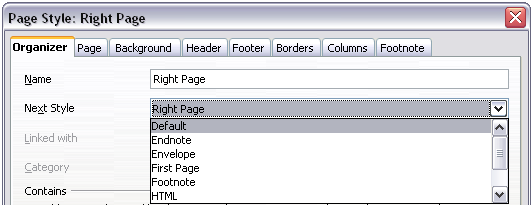
Specifying the next style after the first page of a chapter.
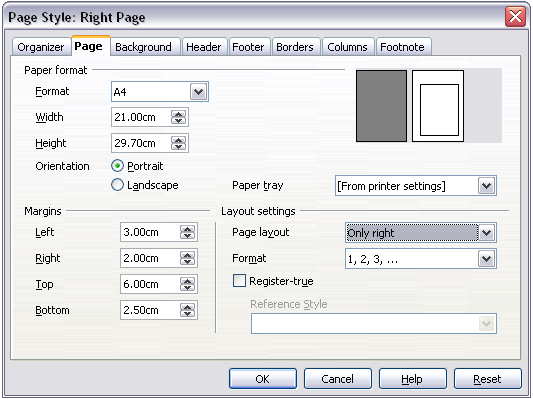
Setting page margins and layout for the Right Page style.
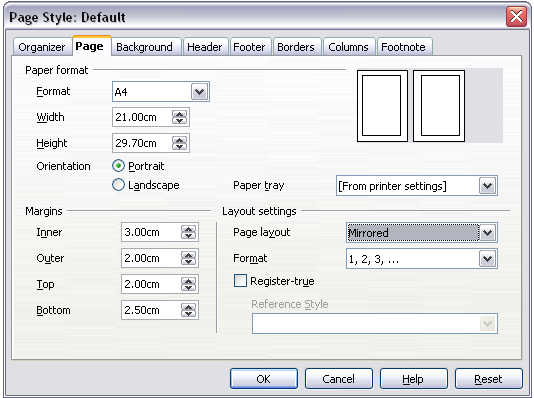
Setting page margins and layout for the Default page style.

Setting up the header properties for the Default page style.

Setting a paragraph style to start on a page of a selected style.
| By default, paragraph style Heading 1 is assigned to Outline Level 1. The assignment of paragraph styles to outline levels is done through Tools > Outline Numbering. |
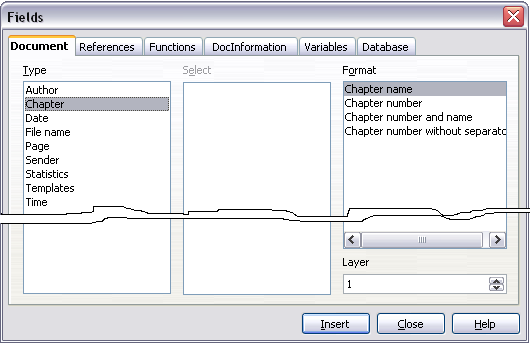
Inserting a chapter title into the header of a page.
| Content on this page is licensed under the Creative Common Attribution 3.0 license (CC-BY). |